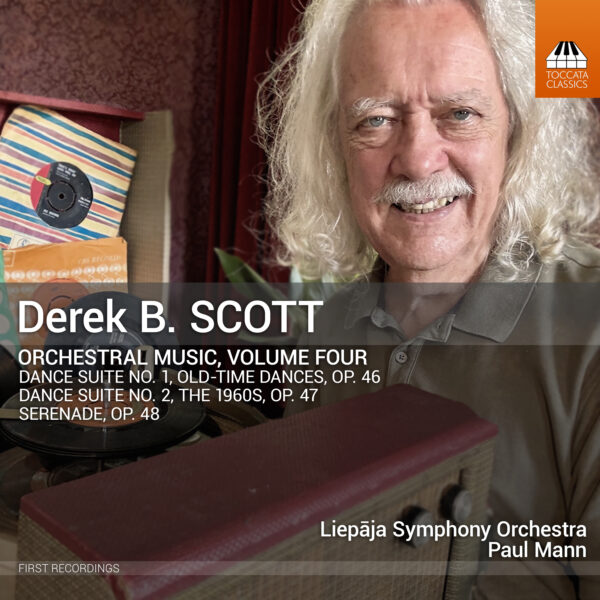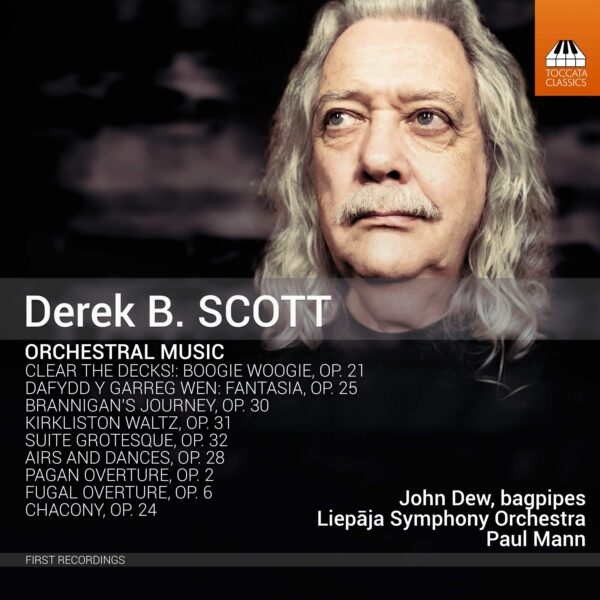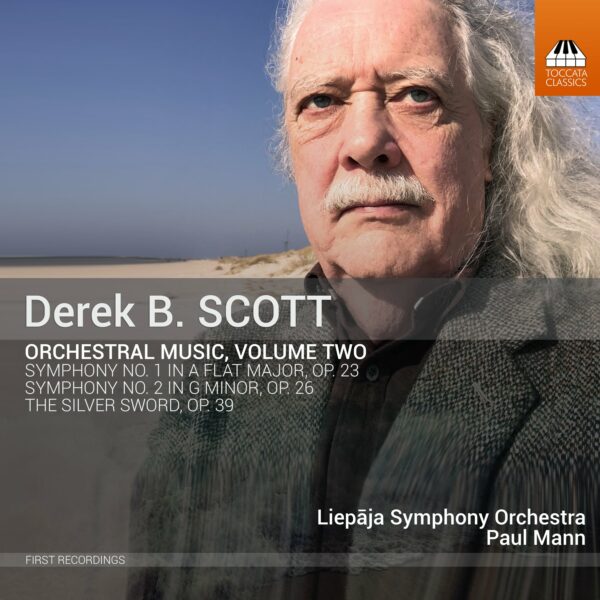Derek B. Scott: Orchestral Music, Volume Four
Derek Scott, born in Birmingham in 1950, has a long history of engagement with the British music hall and other forms of light entertainment, as both historian and performer. Many of his own compositions attest to this interest in popular styles, with his craftsmanship and natural feeling for a good tune producing music of immediate appeal. One of his two recent Dance Suites takes its cue from ska, the twist and other enthusiasms from the early 1960s, and the other from older dance favourites. Time was when works like Arthur Benjamin’s Jamaican Rumba and Percy Faith’s arrangement of Alfvén’s Swedish RhapsodyNo. 1 could be heard on every domestic radio and record-player; these good-natured Dance Suites recapture some of that lost innocence and its relaxed energy – but his Serenade, another recent composition, touches gently on deeper feelings.
Liepāja Symphony Orchestra
Paul Mann, conductor
Listen To This Recording:
Dance Suite No. 2, The 1960s, Op. 47
- I. Boogaloo (5:43)
- II. Mashed Potato (6:01)
- III. Frug (5:32)
- IV. Watusi (4:43)
- V. Skank (3:54)
- VI. Twist (5:29)
Serenade, Op. 48
- I. Romance (5:19)
- II. Nocturne (4:45)
- III. Sapphic Ode (3:07)
- IV. Llandaff (3:26)
Dance Suite No. 1, Old-Time Dances, Op. 46
- I. The Brown Humber (English Waltz) (4:44)
- II. Hazel (Tango) (4:55)
- III. Pool Farm (Polka) (3:58)
- IV. Amy J. Blues (Slow Drag) (5:06)
- V. Sal & I (Country Two Step) (4:50)
First Recordings




MusicWeb International :
‘[ance Suite No.2] is the kind of suite that would go down very well at concerts of light music – music of expert orchestration, strong themes, tangy moments and the ultimate in enjoyment. […]
In addition to the composer’s own booklet notes which are as direct and refreshing as ever […] The recording is finely balanced and the Liepāja Symphony continues to produce hard working and lively results under Mann.’
—Jonathan Woolf, MusicWeb International
Fanfare :
‘[Dance Suite No. 1] is very laid-back and stately, and quite direct in its appeal. “Hazel” is a full-fledged tango, an utter delight. […] The Suite closes with the country two-step, “Sal & I,” a spritely and jovial piece that fitly closes a most delightful work. […]
[the Serenade] opens with a beautiful “Romance” that will induce a calm spirit in the listener through its beautiful sonorities and skillfully interwoven lines. This movement and the following equally gorgeous “Nocturne” began their existence as piano pieces from the composer’s undergraduate days at the University of Hull. Their craftsmanship demonstrates the composer’s impressive capabilities even as a 20-year-old student. […]
Paul Mann and the Liepāja Symphony Orchestra do their usual exemplary job in bringing these new works to life. Listeners who are fond of lighter classical music, or just want to have music to kick off their shoes to enjoy a good cup of tea and relax, will (indeed) find this program itself just their cup of tea. An all-around high recommendation.’
—David DeBoor Canfield, Fanfare
Fanfare :
‘All I can say is, if the opening “Boogaloo” [in the Dance Suite No. 2] doesn’t make you kick up your heels and dance, I don’t know what will. . But each one of these six dance movements is filled with aural delights of harmonic surprises, novel touches of orchestration, and always, always, the fidelity first and foremost to the most beautiful melody. If you want an elixir that comes in the form of music that’s infectious, fun, enlivening, and that will put a skip in your step, this is it. It made me feel young and beautiful again—not that I was ever either of those things—such is the transformational magic of Scott’s music. […]
The first number [of the Dance Suite No. 1, “Old-Time Dances], “The Brown Humber (“English Waltz),” is of a breathtaking beauty. […]
If, as stated above, “The Brown Humber” from the Suite No. 1 is of breathtaking beauty, I’m not sure what superlatives I can come up with to describe the opening “Romance” of the Serenade. Let me just say that in the moment, I can’t think of a slow movement from any 19th- or early 20th-century orchestral work by any Romantic or post-Romantic-period composer that throbs with greater heartfelt pathos than this movement. Its song of sorrow is sincere and profoundly moving. […]
[…], people will be listening to the music of Derek Scott long after Stockhausen is remembered merely as something that stuck to Thomas Beecham’s shoe. […]
Nor is it just the “Romance” from Scott’s Serenade that’s to be embraced and cherished; the remaining four movements of the work are equally exquisite. The musicians of the Liepāja Symphony Orchestra under the baton of Pau Mann sound as if playing these works by Derek Scott was a labor of love. I know you’ll love them too. Urgently recommended.’
—Jerry Dubins, Fanfare
Fanfare :
‘He is an effective and imaginative orchestrator who has the desirable ability to write hummable melodies. He also incorporates familiar pop tunes but expands and develops them. =
Two suites of dances, each lasting around half an hour, could easily wear out their welcome, but Scott’s inventive use of the orchestra, the variety of color he elicits, and the freshness of the tunes combine to keep the listener engaged. I found myself unconsciously tapping my toes throughout. […]
[The Serenade] has a touch more gravitas but is enjoyable for the same inventive qualities as the Dance Suites. The mood is less perky, more broadly lyrical, while still demonstrating his melodic gift. The opening “Romance” is particularly affecting, but all four movements touch the heart. The title Serenade implies a work in which beauty is a prime consideration, which is the case here. […]
conductor Paul Mann’s enthusiasm for the music is evident in its liveliness. Toccata’s recorded sound is up to its usual high level.’
—Henry Fogel, Fanfare
Fanfare :
‘These are tonal works, brimming with hummable melodies, vigor, and of course fetching dance rhythms. They are both great fun!
[…] like the Dance Suites, the Serenade is scored with transparency, elegance, and a mastery of orchestral colors. […]
As in Vols. 1–3, Scott’s music is played by the Liepāja Symphony Orchestra and conductor Paul Mann. The performances are excellent, offering precision, tonal beauty, and a keen balance among the instrument families. […] these are first-rate performances of immensely enjoyable music. Recommended. ‘
—Ken Meltzer, Fanfare
Fanfare :
‘Scott’s writing [in the Dance Suite No.1] is slick and expert, and the Liepāja strings are as smooth as any 1960s studio assembly for a jazz section. […]
Gosh,[the Dance Suite No.2] is fun. […]
The recording is excellent. […] It’s a superb release that finds Scott’s music caught in a fine recording and in enthusiastic performances. Recommended.’
—Colin Clarke, Fanfare
Fanfare :
‘The [Dance Suite No.1] as a whole had me smiling and felt like a satisfying way to conclude the album.
Simple, unpretentious, adroitly composed and orchestrated, this album will undoubtedly appeal to lovers of light music, […]. {Scott] is very fortunate to have the services of the Liepāja Symphony Orchestra and Paul Mann, who give us highly accomplished performances of all the pieces and seem to instinctively understand the idiom Scott is evoking. Good fun.’
—Dominic Hartley, Fanfare